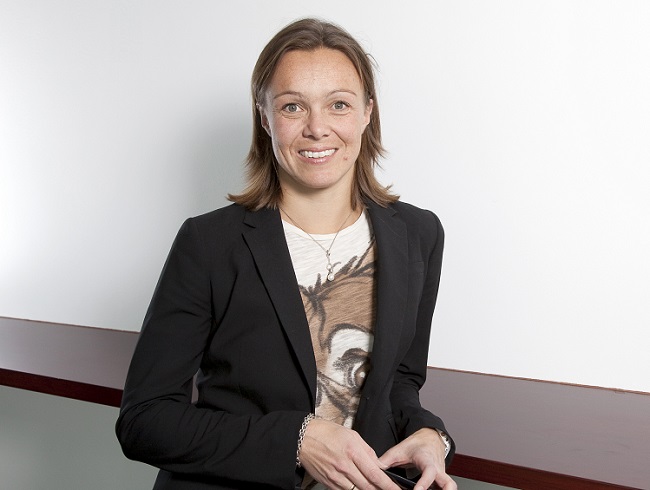Echelon: How telcos can forge a path through today’s OTT world
By Benjamin Cher June 17, 2016
- Collaboration is key for telcos to become ‘smart’ pipes
- Don’t hide in a walled garden, play a part in the ecosystem

THE tale of the tape between telcos and over-the-top (OTT) players has usually been read thus: Dumb pipes serving bandwidth for others to make money off of.
Telcos have fought back by launching various services on their own, with varying levels of success.
But this mentality of needing to fight off the competition has to change if telcos are to forge a path in today’s OTT world, according to Karianne Melleby (pic above), vice president and head of global partnerships at Telenor Digital AS.
Telcos sit on a gold mine – their customer base and their vast amount of customer data – that is highly sought after by OTT players.
Being able to collaborate and build something from this would differentiate the dumb pipes from the smart pipes, she told Digital News Asia (DNA) on the sidelines of Echelon Asia Summit 2016, the latest in the series of annual startup conferences organised by Singapore-based tech blog e27.
“Turning [telcos] into smart pipes would give new opportunities in terms of adding value to the OTT players,” she said after having appeared at a panel discussion at Echelon.
One example of a smart pipe player would be mobile wallets. For telcos, it represents a new way of engaging with their customers, according to Melleby.
“As for the new services we are building in financial services, health and storage, they are all accessible from people outside of our telecom footprint,” she said.
“That is a very new way of approaching the market from our end – it’s about not thinking of the same footprint, but about building products that will be available for everybody in that market – even globally.
“That’s thinking like an Internet service provider, rather than about how I can lock in customers in a walled garden.
“So all the things we have been doing in the last two to three years have been about increasing accessibility to the services we are creating,” she added.
Formed in 2011, Telenor Digital is the digital services subsidiary of Norwegian telco giant Telenor Group.
It’s my infrastructure, dammit
 The biggest gripe telcos have is that they foot the bill on infrastructure, while OTT players merely piggyback off their networks and make a profit without paying their dues.
The biggest gripe telcos have is that they foot the bill on infrastructure, while OTT players merely piggyback off their networks and make a profit without paying their dues.
Melleby doesn’t believe telcos should gripe overly much about this. “It is a good position to be in, to have a product that lots of people want to use,” she said.
“The good thing is that the big players such as Google, Facebook and YouTube, recognise that and encourage us to continue invest in our networks.
“For example Facebook Flex is a stripped-down version with no pictures, but when you turn on data you get the full version – these are products we are co-creating to help people get online, and which contribute to us further investing in our networks,” she added.
The need for telcos to continue building out their networks is something everyone acknowledges. “Future investment for exponential growth in data consumption is needed, and no telco will continue to be in that space if no-one pays for it,” said Melleby.
There are others nipping at the heels of traditional telcos, such as mobile virtual network operators (MVNOs) which lease bandwidth from the telcos themselves.
Melleby sees them – as well as software telcos – as a cost-efficient way of delivering services.
“In my world, a telco delivers three services: Voice, messaging and data. MVNOS are creating these services more cost-efficiently, and that is what we should do as well,” she said.
Tearing down walls
The good news is that many telcos today are more open to the idea of collaborating, and are even embracing, and learning from, startups.
“We have launched accelerator programmes in five out of six Asian markets – we embrace not just telco- or closely-related startups, we embrace digital startups with good ideas and solid teams,” said Melleby.
“In [Asia], we are engaging much more broadly now than two years ago, with a clear focus on mobile-first or mobile-only products.
“We have learned a lot from this; we engage and co-create, we have teams who are more eager to talk to people and who understand we are participating in an ecosystem,” she added.
This is in sharp contrast to only a few years ago, when walled gardens and closed ecosystems were the order of the day in the telco space.
“Five years ago, we understood things were happening, but we didn’t see any way to set down the first step,” said Melleby.
“Whereas now we have opened up, tore down some walls, started to learn, and are on that journey.
“I think the next thing to feel comfortable about is participating in an ecosystem – not only in delivering our own services, but being comfortable with being one piece of a total ecosystem.
“In that, we still have some ways to go,” she acknowledged.
Related Stories:
Digital services key to telco survival: Telenor Digital head
Sigve Brekke’s ‘burning platform’ mentality to move a giant
OTT voice revenue to grow 5x in 5yrs, operators in trouble: Juniper Research
For more technology news and the latest updates, follow us on Twitter, LinkedIn or Like us on Facebook.


